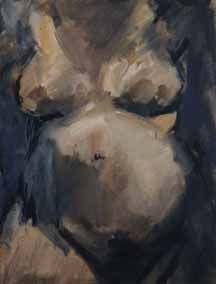| As my pregnancy developed I found standing poses increasingly uncomfortable and so, partly for practical reasons, I decided to work from a seated position. Study for self-portrait, July 1984, is among the first of these. The figure dominates the composition, facing the viewer directly. The pose, which in the earlier drawing is upright and alert with both hands on the knees, has sunk into a relaxed and weary attitude. One hand supports the head and the gaze, whilst being directed outwards, fails to engage completely with the viewer, suggesting a preoccupation with the self.
After the more intensely worked drawings, I felt that I was now moving in the direction I wanted. The lines were stronger, more expressive of the form and, most of all, contained a real sense of heaviness, weight and fullness. On an emotional level I was beginning to catch the sense of repose and expectancy – that kind of passive expectancy felt by the all-night traveller, alone in the small hours, waiting in some deserted station.The drawing had sufficient formal strength to withstand development into a large oil painting and during this process many more changes took place; each refinement kept the work alive. While some artists prefer to work out all their formal problems in preparatory drawings which they then transfer onto a squared-up canvas, I am temperamentally unsuited to such procedures. Although my method is less certain in terms of destination, I prefer to know only the direction in which I am travelling. This allows the journey to be charted each step of the way, keeping my sense of exitement alive at all stages. |
 Seated self-portrait with hands on knees Seated self-portrait with hands on kneescharcoal on paper 76cm x 56cm 30″ x 20″ |
 Standing pregnant figure in pink Standing pregnant figure in pinkoil on board 53.5cm x 40.5cm 21″ x 16″ |
When studies and drawings are complete I pin them on the studio walls around me. I go on to make small oil sketches, often on panels which can withstand and preserve the developments that occur as I continue to draw into the painting with charcoal. The grains of charcoal mix with the paint, adding to the textural and tonal effect. In this way the drawn line creates a dynamic dialogue with the painted areas. These wooden panels have the resilience necessary for the rough treatment they receive. The paint is applied with rapid brushwork using large hogs hair brushes, continually re-defining forms until the painting is resolved.
Colour, too, is of great importance. My use of colour is intuitive and although initially it is based on observed reality, as the work progresses certain tones and colours are heightened or reduced in a continual balancing act. The elements of line and colour battle or harmonise together, aiding the expression of the subject matter and welding the picture into a strong cohesive unit in which the hands and face become the expressive mainspring. |

Self-portrait: leaning |

Torso |
The studies took the image through several successive stages of simplification and during this process the figure became larger within the confines of the picture area and the background detail of the studio was replaced by flat areas of colour. The table that the arm rests on and the structural lines of the easel became heavy bands of dark colour at the top and the left hand side. This closing of the picture space around the figure gave the sense of massiveness and isolation that I sought in the initial sketches.
I arrived at an image that for me satisfatorily described the experience of my pregnancy. It was only later, in conversation with my husband, that I recognised an affinity between my painting and Durer’s wonderful image of Melancholia.
Study for self-portrait
oil on board
86.5cm x 61cm
34″ x 24″
Just when I felt my work was going well life rudely interrupted art when my son Maxim was born almost a month earlier than expected and the large oil painting that I had only just begun remained unfinished. And so it is today.
The continuous development of my baby kept presenting me with new subject matter demanding to be recorded. Perhaps when the speed of these changes slows down I will return to finish it, or possibly its very incompleteness represents the experience of the birth of my first child.



